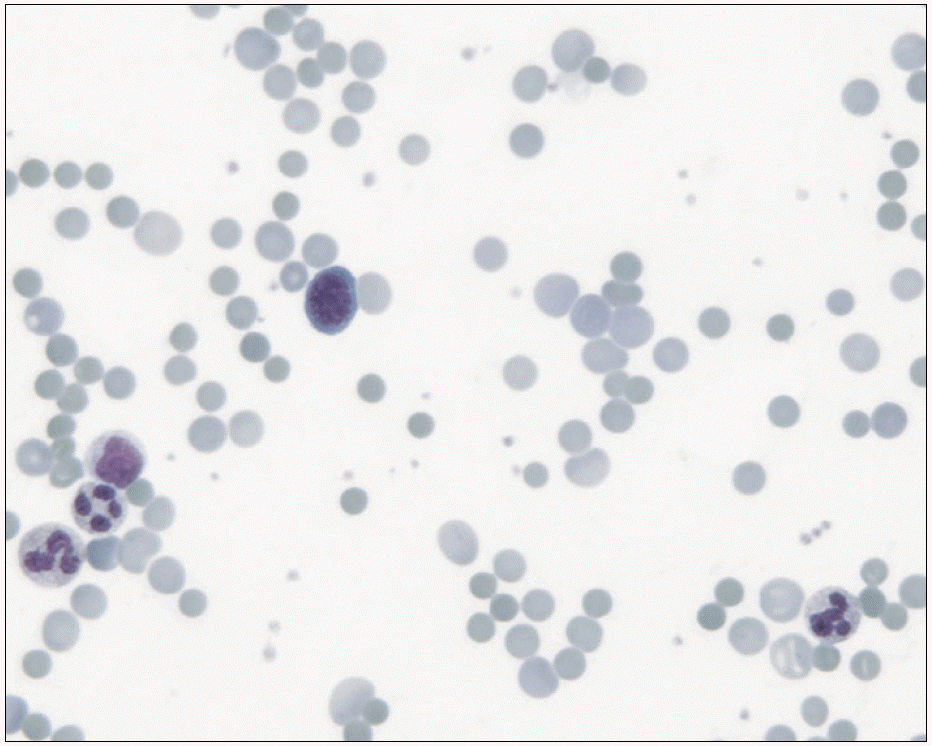Abstract
Idiopathic CD4+ T-lymphocytopenia (ICL) is defined by the CDC as depressed numbers of circulating CD4+ T-lymphocytes (<300 cells/μL or <20% of the total T cells) on more than one determination, with the absence of HIV infection and other known causes of immunodeficiency. The clinical spectrum of ICL ranges from asymptomatic laboratory abnormalities to severe opportunistic infections that mimic the clinical course of human immunodeficiency virus (HIV) infected patients. There are a few reports of ICL associated with different diseases such as Sjogren's syndrome, pulmonary sarcoidosis, Down syndrome or non-Hodgkin's lymphoma. We describe here a 5-year-old male patient with a three-year history of recurrent otitis media and pulmonary infection, and he was without any risk factors for HIV infection; this patient presented with autoimmune hemolytic anemia and was ultimately found to have idiopathic CD4+ T-lymphocytopenia.
REFERENCES
1). Centers for Disease Control (CDC). Unexplained CD4+ T-lymphocyte depletion in persons without evident HIV infection –United States. MMWR Morb Mortal Wkly Rep. 1992. 41:541–5.
2). Busch MP., Valinsky JE., Paglieroni T, et al. Screening of blood donors for idiopathic CD4+ T-lymphocytopenia. Transfusion. 1994. 34:192–7.

3). Smith DK., Neal JJ., Holmberg SD. Unexplained opportunistic infections and CD4+ T-lymphocytopenia without HIV infection. An investigation of cases in the United States. The Centers for Disease Control Idiopathic CD4+ T-lymphocytopenia Task Force. N Engl J Med. 1993. 328:373–9.
4). Lepur D., Vranjican Z., Barsic B., Himbele J., Klinar I. Idiopathic CD4+T-lymphocytopenia-two unusual patients with cryptococcal meningitis. J Infect. 2005. 51:E15–8.

5). McLane NJ., Weems JJ Jr., Antworth MV. Cytomegalovirus retinitis in a patient with idiopathic CD4+ T-lymphocytopenia. Clin Infect Dis. 1994. 18:1012–3.
6). Tanaka S., Teraguchi M., Hasui M., Taniuchi S., Ikemoto Y., Kobayashi Y. Idiopathic CD4+ T-lymphocytopenia in a boy with Down syndrome. Report of a patient and a review of the literature. Eur J Pediatr. 2004. 163:122–3.

7). Paolini R., D'Andrea E., Poletti A., Del Mistro A., Zerbinati P., Girolami A. B non-Hodgkin's lymphoma in a haemophilia patient with idiopathic CD4+ T-lymphocytopenia. Leuk Lymphoma. 1996. 21:177–80.

8). Sinicco A., Maiello A., Raiteri R, et al. Pneumocystis carinii in a patient with pulmonary sarcoidosis and idiopathic CD4+ T lymphocytopenia. Thorax. 1996. 51:446–7.

9). Schattner A., Friedman J., Bentwich Z. Opportunistic infection due to unexplained CD4+ lymphocytopenia and associated Sjogren's syndrome. Rheumatology (Oxford). 2004. 43:111–2.

10). Misbah SA., Chapel HM. Idiopathic CD4+ T-lymphocytopenia. Lancet. 1992. 340:609.
11). Spira TJ., Jones BM., Nicholson JK, et al. Idiopathic CD4+ T-lymphocytopenia-an analysis of five patients with unexplained opportunistic infections. N Engl J Med. 1993. 328:386–92.
Fig. 1
The peripheral blood smear showed severe anemia with RBC agglutination, polychromasia, spherocytes, and normoblasts (Wright stain, ×1,000)

Table 1.
Past medical history for this patient
Table 2.
The results of antibody screening test and Direct Coombs’ test
| Age (years/months) | Antibody screening | Direct Coombs’ test | |||
|---|---|---|---|---|---|
| Selectogen I | Selectogen II | IgG | C3d | Auto contro | |
| 5/3∗ | 4+ | 4+ | 4+ | - | 4+ |
Table 3.
The results of immunoglobulin quantitation test and complement test
| Age (years/months) | IgG mg/dL | IgA mg/dL | IgM mg/dL | IgD mg/dL | IgE IU/mL | C3 mg/dL | C4 mg/dL | CH50 U/mL |
|---|---|---|---|---|---|---|---|---|
| 3/6 | 1,681 | 59 | 149 | NT | NT | 125 | 22 | 18.6 |
| Reference ranges∗ | 400~1,250 | 24~192 | 41~200 | 0~14 | 0.0~29.2 | 70~150 | 10~30 | 23~46 |
| 5/3† | 2,108 | 63 | 162 | 2.1 | 1.5 | 106 | 19 | 31.7 |
| Reference ranges∗ | 560~1,307 | 26~232 | 47~200 | 0~14 | 0.2~17.6 | 70~150 | 10~30 | 23~46 |
Table 4.
The results of lymphocyte subset test




 PDF
PDF ePub
ePub Citation
Citation Print
Print


 XML Download
XML Download